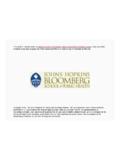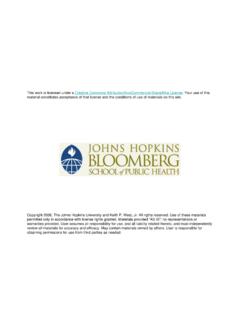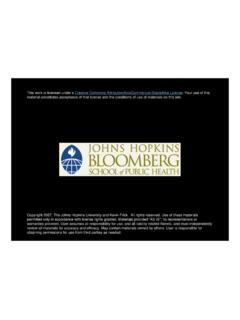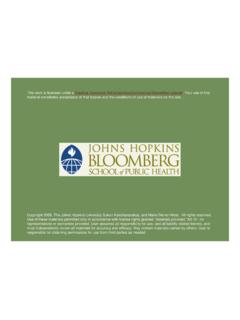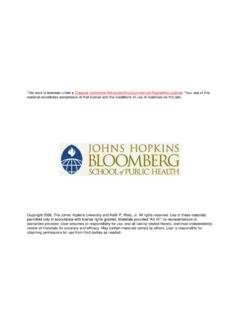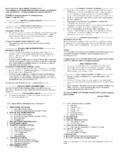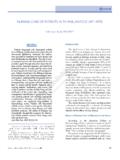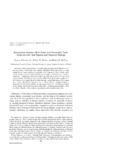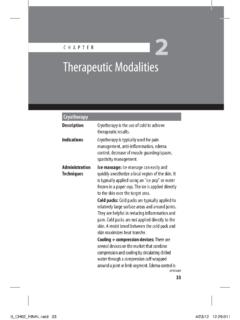Transcription of This work is licensed under a Creative Commons …
1 Copyright 2008, The Johns Hopkins University and Mary Foulkes. All rights reserved. Use of these materials permitted only in accordance with license rights granted. Materials provided AS IS ; no representations or warranties provided. User assumes all responsibility for use, and all liability related thereto, and must independently review all materials for accuracy and efficacy. May contain materials owned by others. User is responsible for obtaining permissions for use from third parties as work is licensed under a Creative Commons Attribution-NonCommercial-ShareAlike License. Your use of this material constitutes acceptance of that license and the conditions of use of materials on this GroupsMary Foulkes, PhDJohns Hopkins UniversitySection AControl Groups4 Adequate and Well-Controlled Studies: 21 CFR Generally, the following types of controls are recognized:i.
2 Placebo concurrent controlii. Dose-comparison concurrent controliii. No treatment concurrent controliv. Active treatment concurrent controlv. Historical control5 Purpose of the Control Group To allow discrimination of the patient outcome from an outcome caused by other factors (such as natural history or observer or patient expectation) To avoid bias (any aspect of the design, conduct, and analysis that would make the estimate of the treatment effect deviate from thetrue effect)6 Two Techniques to Control Bias Randomization (randomly dividing a single population to avoid systematic differences between study groups with respect to baseline variables that could effect outcome) Blinding (helps assure that the study groups are treated in a similar manner during the trial)
3 7 ICH E10 Placebo No treatment Different doses or regimens of same treatment Different active treatments Historical (external and non-concurrent)8 ICH E10 Ethical and practical issues Impact on study design Study objective Ability to minimize bias Usefulness in particular inference situations Advantages and disadvantages9 Placebo Concurrent Control Usually randomized double blind Goal: to show a difference (for efficacy) Goal: to show equivalence (for safety) Ethical When no effective treatment exists or when add on studies or early escape designs are appropriate Needs no assumption of sensitivity to drug effect nor assay sensitivity10No-Treatment Concurrent Control Usually randomized May be difficult to blind Important that study endpoints are objective Potential for observer bias needs to be assessed Validation of ability to detect drug effect and assay sensitivity is required11 Dose-Response Concurrent Control Goal.
4 To establish a relationship between dose and efficacy and safety Usually randomized and double blind May include other control groups (active or placebo) Doses may be fixed or gradually raised If the therapeutic range is not known, the design may be inefficient12 Active Concurrent Control Ethical whenever approved drugs are available for the disease under study Randomized Double blind Goal: to show equivalence, non-inferiority, superiority Goal: could relate to both efficacy and safety13 Historical Controls No randomization No blinding Source of controls external to the present study Patients in control group were treated at earlier time Patients in control group treated in another setting14 Concurrent Controls Systematic assignments can bias study and should generally be avoided Randomized trials are the gold standard 15 Purpose of a Clinical Trial Assessment of efficacy, safety, or benefit:risk Goal may be superiority, non-inferiority, or equivalence In a regulatory setting.
5 The goal may be to show that the drug has the effect it purports to have 16 Conclusions Active control trials are here to stay The goal is usually to obtain an indirect test of effectiveness Active control trials will become more common in phases II and III Active control trials need to be carefully preplanned (setting, choice of control, what the goal is, choice of delta or margin) Changing goals (equivalence to non-inferior is not an option)17In the Next Section We ll Look at .. More on control groups Placebos, in particularSection BPlacebos19 Definitions Placebo: a form of medical therapy, or an intervention designed to simulate medical therapy, without specificity for the condition being treated Placebo effect: the change in the patient s condition that is attributable to the symbolic import of the healing intervention rather than to the intervention s specific pharmacologic or physiologic effectsSource: Brody, H.
6 (1982).20 Rationale for Use of Placebos Discriminate outcomes due to intervention (new product) from outcomes due to other factors Estimate efficacy Interpret adverse events Minimize bias, maximize accuracy and reliability21 Source: Spilker, Fr. (1991).Uncontrolled/Controlled ResultsPercentage of positive findingsTherapeutic areaUncontrolledControlledPsychiatric83% 25%Antidepressant57%29%Respiratory distress89%50%Rheumatoid arthritis62%25%22 Source: 21 CFR of Controls Placebo concurrent controls Dose-comparison controls No treatment concurrent controls Active treatment concurrent controls Historical controls23 Use of Placebo/No RX Control Control for influences other than study agent Concomitant therapy, regression to the mean, placebo effect Placebo permits blinding Reduces bias in therapeutic management Reduces bias in outcomes assessment May decrease drop-outs, crossovers, in Trials Not all trials using placebos are placebo-controlled Double-dummy (A + PB vs.)
7 PA + B) Placebo run-in (P then A vs. P then B) Not all placebo-controlled trials involve giving no treatment Add-on (A + B vs. A + P)Source: Brody, H. (1982).25 Source: See World Medical Association 2001, Declaration of HelsinkiEthics of Placebos Ethical where no available tx Unethical in the context of an available tx to prevent or delay death Ethical if no permanent harm in delaying available active tx forthe duration of the trial26 Source: Ellenberg, Fr. and Temple. (2000). Ann Intern Is No More Effective than OldDrug classExisting drug(s)New agentsAdvancesAntidepressantsTricyclicsS SRIs and othersDifferent, tolerable array of side effectsAntipsychoticsPhenothiazines, buterophenonesRisperidone, olanzapine, quetiapineDecreased extra- pyramidal effects AntihistaminesSedating antihistaminesNon-sedating antihistaminesLack of sedationAnti- inflammatoryNon-selective NSAIDSCOX-2 selective NSAIDsImproved GI toleranceAnti- hypertensivesDiurectics, reserpineLow dose diurectics, ACE inhibitors, calcium channel blockersElimination of important side effects27In the Next Lecture We ll Look at.
8 Outcomes and endpoints Hypotheses Binary endpoints vs. continuous endpoints Subjective vs. objective endpoints Primary, co-primary, and composit
